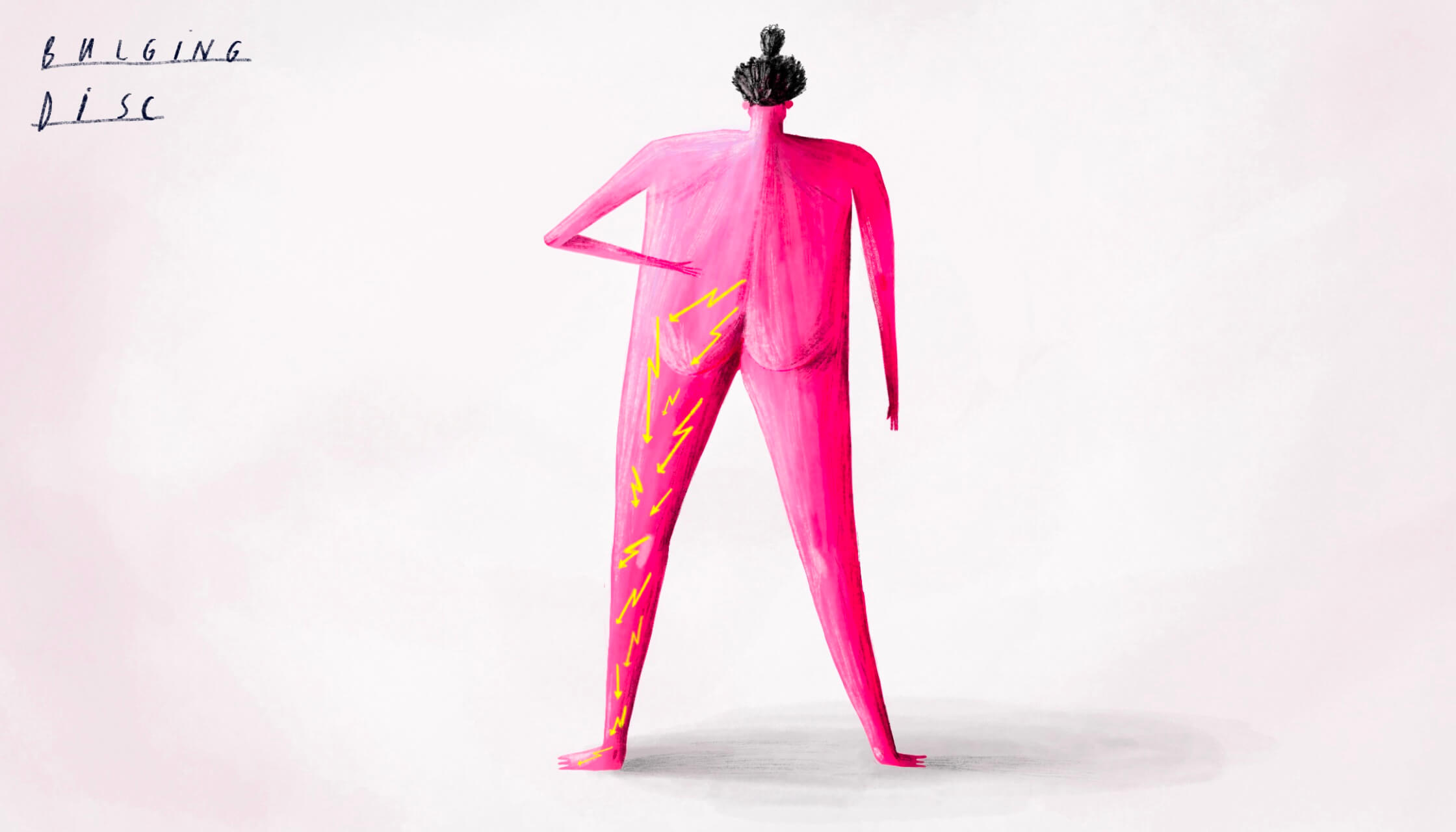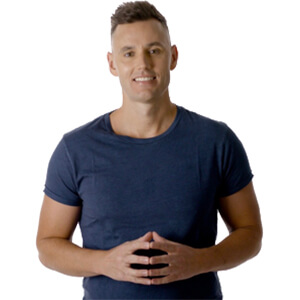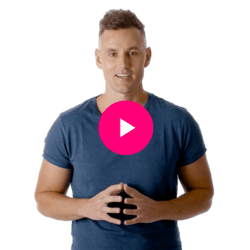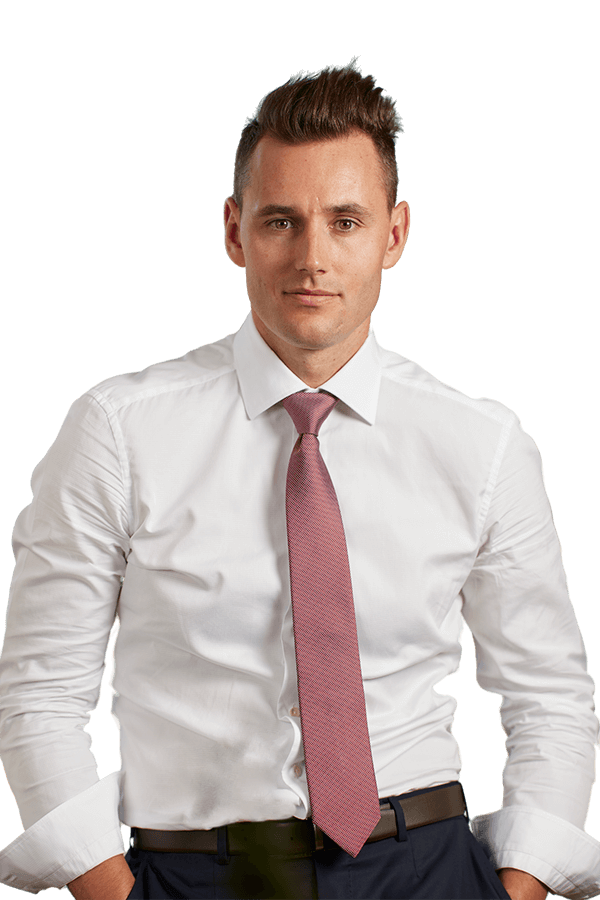Bulging disc
or wear and tear in the spinal disc
Find out more about bulging or herniated discs and the underlying causes.

Neurosurgeon Brisbane
Bulging disc key points
- When it comes to describing a problematic spinal disc, you may have seen terms such as herniated, ruptured or bulging discs and essentially they all mean the same: wear and tear in the spinal disc.
- The two main symptoms of a bulging disc are spine pain or nerve pain (and sometimes both).
- The most common cause is ‘time’. Almost everyone will get disc wear and tear as they age.
- A big part of my job is to determine whether the wear and tear you have is in fact the cause of any symptoms you may have.
- A lot of the time a steroid injection and medication will be all that’s required. But there are three reasons to perform surgery for spinal disc problems: severe pain, persistent pain and weakness.
Normal spinal disc
Background
A normal spinal disc is a beautiful piece of biological engineering. It allows movement in all directions, and it absorbs shock. Both are essential actions as you move around in normal life.
Now imagine a small balloon that you’ve blown up and tied off. Imagine placing one hand under and the other on top of the balloon. You can move your hands relative to each other easily because the balloon just deforms in whichever way you apply pressure.
In the spine, your hands are the two adjacent spinal bones and the balloon is the spinal disc. (Compare this to having in a hand either side of a brick; the brick doesn’t give at all, and you can’t move your hands relative to each other).
In the normal disc, instead of air, it’s actually about 80% water that fills the space! The water is mixed up with special proteins so in real life it looks like this tough gelatinous stuff rather than runny water. We have given the water protein stuff in the centre of the disc a name, the nucleus pulposus.
But unlike the balloon, the disc is also very, very strong. The strength comes from the balloon being wrapped by something called an annulus fibrosus. This is a very tough layer of fibres -about 15 layers thick- that straps the disc firmly in place between two adjacent spinal bones and keeps the watery gelatinous nucleus pulposus in its position in the centre of the disc without allowing it to escape. It is a bit like someone gaffer taping your hands on either side of the balloon together 15 times.
Bulging disc Brisbane
So what is a herniated or bulging disc?
There are many terms when it comes to describing a problematic spinal disc. Do you recognise any of these?
Ruptured disc
Bulging disc
Slipped disc
Protruded disc
Extruded disc
Herniated disc
Collapsed disc
Most of these terms essentially mean the same thing. There are subtle differences but essentially it all means ‘wear and tear’ in the spinal disc.
Wear and tear in turn means one of two things.
Firstly the disc has lost water and becomes dehydrated. This is normal as you get older. In fact, it’s so normal that it is expected to occur during your lifetime. A normal disc is over 1cm in height but this can reduce down to a few millimetres with age.
When the disc slowly collapses down like this (this process does not occur overnight, it occurs over months to years) it can cause spine pain from bone rubbing on bone (there is no longer a nice big juicy nucleus pulposus keeping the two opposing spinal bones from touching).
Nerve pain can also occur due to a pinched nerve. Imagine a car up on a jack. Now imagine how you’d feel if that jack started to fail and the car started coming down on top of you. You’d eventually get squashed if you didn’t do something about it. Well, that’s what happens to a nerve as the disc collapses down to the point where the nerve is jammed. This can cause severe nerve pain.
The second pattern of wear and tear is weakening of the annulus fibrosus (the gaffer tape in the analogy), creating a failure point in the annulus. There is a lot of pressure in the disc just from gravity and your body weight, so when a failure point occurs the centre of the disc (the balloon in our analogy) just bulges out through the annulus under pressure. Sometimes the annulus splits open completely and some of the watery gelatinous nucleus pulposus escapes completely. When this bulging or escaped part of the disc jams a nearby spinal nerve pain often results.
During the assessment, I will ask you questions, examine you and look at your scans to determine if your wear and tear is the silent, non-problematic type or the cause or any symptoms you have. Very often any wear and tear seen on a scan is a red herring, but I can take you through all this when I see you.

Spinal surgeon Brisbane
Bulging disc symptoms
What are the symptoms of a herniated or bulging disc?
The two main symptoms of a ruptured or bulging disc are spine pain or nerve pain (and sometimes both).
In the cervical spine, this would be either neck pain (which often radiates into the shoulder muscles) or nerve pain down the arms (this can very often include pain that is in the shoulder blade, which seems a weird place but is a common area for nerve pain to refer to). Pins and needles can occur often also.
In the lumbar spine, this would be either low back pain (which often radiates into the buttock muscles) or nerve pain down the legs. If the higher discs are involved in the lumbar spine then this nerve pain is called femoratica and it radiates down the front of the thigh or shin, and if it involves the lower nerves then it is called sciatica and it travels down the back of the legs and calf and often into the foot. Don't be too concerned about the terminology, it's more useful for the surgeon.
Is it common, do other people get it?
Nearly everyone gets wear and tear in their spine with age. It’s normal, like getting wrinkles with age. In most people, this normal wear and tear does not cause any symptoms.
A big part of my job is to work out if the wear and tear showing up on your scan is the cause of your symptoms. It is sometimes quite challenging to work this out. It is also very important – there is no point treating wear and tear changes when they are not the cause, something else is.

Spinal surgeon Brisbane
This detective work is critical.
Herniated disc causes
What causes it? Did I do something to cause it?
The most common cause is time. Almost everyone will get disc wear and tear as they age.
Certain activities will put you at risk also. The most common is heavy lifting, particularly while bending forward (called flexion) or twisting. Twisting is the big one. If you repeatedly load your spine with heavyweight and twist your chances of accelerating the wear and tear in your disc go up significantly, which in turn increases your chances that you will get symptoms from it at some point.
A lot of people say “I just sneezed and bang, my back went out and I got nerve pain.” The reality is the act of sneezing (which does put a very small amount of pressure through the spine) was the straw that broke the camel’s back. The problem was an accumulation of forces on the disc over the months in years previously that slowly weakened the disc.
Remember that almost everyone walking around in the world has some degree of disc wear and tear or bulging disc. If it causes symptoms and you get either spine pain or nerve pain, then much more often than not this is not dangerous.
There is only one situation where it is dangerous, and that is if the nerves to the bladder are injured and your bladder stops working properly. Pain itself can disrupt bladder function (this is in fact very common but not dangerous), but if the bulging disc is physically compressing bladder nerves and the bladder stops working because of this compression then you need urgent surgery. While pain causing bladder problems is common and not dangerous, fortunately, bladder problems from squashed nerves are rare.
This is not genetic. It is just your body’s response to force and stress over time.
The cervical spine and the lumbar spine are the two most common areas to be affected. The thoracic spine is very uncommonly affected.
Bulging disc treatment in Brisbane
How is it treated?
This all depends on what your symptoms are and what your scan looks like. It also depends on you, your age, lifestyle and quality of life you want to live. All these factors will be taken into account to determine what will be the best treatment for you.
A lot of the time a steroid injection and medication will be all that’s required.
Most of the surgical options are keyholes.
A thorough assessment will make it clear what treatment is best for you.
Herniated disc surgery Brisbane
Do I need surgery?
There are three reasons to perform surgery for spinal disc problems:
- Severe pain. Keyhole surgery is effective at immediate relief of pain without requiring repeated treatments.
- Persistent pain. Some patients have had pain for months and months and just need an end to it.
- Weakness. If a nerve is squashed to the point that signals stop getting through to the muscles then surgery is usually required to take pressure off the nerve and allow it to recover as much as possible.
The decision really depends on your quality of life.
If you are coping OK with rest, steroid injections or medication, then it is usually safe to continue with that strategy. If you are sick of the pain, sick of the medication and its side effects then keyhole surgery is often an effective and simple way to reach the end point the quickest and stop the pain.

Bulging disc surgery Brisbane
The best way to minimise wear and tear occurring in the disc and potentially getting symptoms is to minimise stress on the spine. Good lifting technique and avoiding excessive rotation of the spine, particularly when carrying heavy load is vital.
Most people who have symptoms from disc wear and tear eventually recover with either surgery or rest and medication. The only variable is time. Surgery will expedite recovery, but is only required if your quality of life is suffering as a result of the symptoms, or you have weakness or bladder problems.
Bulging disc spinal surgeon Brisbane
What should I do now?
If you are concerned about symptoms of spine pain or nerve pain then it is advisable to get a specialist opinion. Feel free to contact my team here. This does not necessarily mean you need surgery but it does allow a full professional assessment of your spine and symptoms to be performed so you can start getting back to your normal quality of life. There are many factors that need to be examined and looked at and I would be very happy to help you with this.
Ready to make an appointment?
Ramsay Specialist Centre
Suite 325
Newdegate St
Greenslopes QLD 4120

